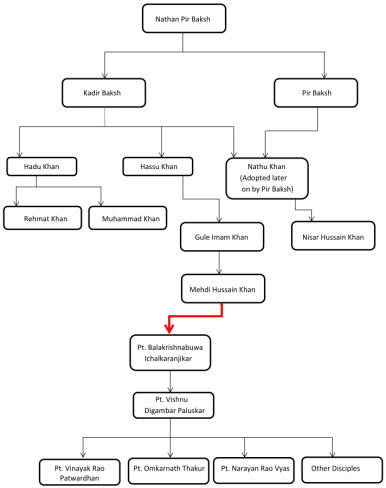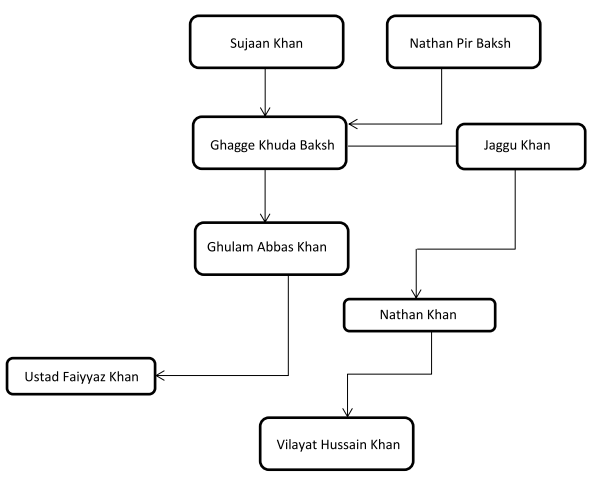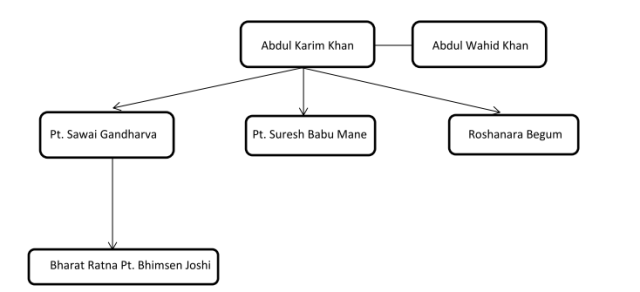
Hey Guys, thank you for your great reviews on my last article based on the different parts of tanpura, this article will be based on the different gharanas in our Hindustani vocal music. Gharana- as defined in my 2nd article (http://edtimes.in/2013/10/indian-classical-music-part-2.html) in simple words is a system which links musicians and classical dancers to a lineage or apprenticeship by adherence to a particular musical style of singing or of dancing. The word gharana is derived from a Hindi word ‘Ghar’ meaning home or family; typically it refers to a place from where a particular tradition started.
Different gharanas have different styles of singing and playing instruments. The same raag is rendered differently in different gharanas. Gharanas in vocal music are different gharanas in instrumental music. Some gharanas in Hindustani Vocal music are-
- Gwalior Gharana
- Agra Gharana
- Delhi Gharana
- Patiala Gharana
- Kirana Gharana
- Mewati Gharana
- Jaipur Gharana
- Indore Gharana
- Bhendi Bazaar Gharana
- Banaras Gharana
- Rampur-Sahaswan Gharana
- Qawwal Bache Gharana
- Sham Chaurasia Gharana
It is recommended that you read my article based on different compositions in Hindustani music before going forward (http://edtimes.in/2014/02/hindustani-music-part-6.html ). Now I’ll talk about the lineage and characteristics of each gharana-
Gwalior Gharana
This is one of the oldest gharana; originated in Mid-16th Century by Nathan Pir Baksh. He had 2 sons, Kadir Baksh and Pir Baksh. Kadir Baksh was a court singer in the court of Maharaja Daulatrao (of Gwalior) and had 3 sons- Hadu Khan, Hassu Khan and Nathu Khan. Nathu Khan one of the best singers of that time was later adopted by Pir Baksh. Hadu khan had 2 sons- Rehmat Khan and Muhammad Khan. But these became prominent singers of Indore Gharana and not of Gwalior Gharana. Hassu Khan had 1 son named Gule Imam Khan who in turn had one son named Mehdi Hussain Khan. Pt. Balakrishnabuwa Ichalkaranjikar came under this lineage only. He is, as told before in one of my previous articles (http://edtimes.in/2014/05/hindustanimusic.html ), teacher of the legendary musician Pt. Vishnu Digambar Paluskar. The following flowchart will help you understand better-

There were many other musicians in between Mehdi Hussain Khan to Pt. Balakrishnabuwa Ichalkaranjikar (Marked in Red colour) which are not known even till date. This gharana is famous for its Khyal singing. The singer’s voice is very powerful and importance is given to practice/riyaaz. Gamak is often seen in the singing with the help of taan. Behlawa or Bol-taan is also seen in the singing. Generally a performance in Gwalior Gharana ends with a Tarana instead of the usual Thumri singing tradition. You can follow the given link and listen to an amazing raag rendition by some of the senior singers of this Gharana-
1. Pt. Omkarnath Thakur- http://www.youtube.com/watch?v=gApWs6LO0Ww
2. Pt. DV Paluskar- http://www.youtube.com/watch?v=MHDjln-cUZo
Agra Gharana
Agra gharana was founded by Sujaan Khan which was later on popularised by Ustad Ghagge Khuda Baksh in 1790s and is very close to Gwalior Gharana. Ghagge Khuda Baksh was a disciple of Nathan Pir Baksh of Gwalior Gharana and after learning Khyal singing for several years from him, Ghagge Ji settled in Agra; thus the key features of Gwalior gharana were passed on to the Agra gharana. Ghagge Khuda Baksh had a brother named Jaggu Khan and a son named Ghulam Abbas Khan. Ghulam Abbas Khan was the guru of Jaggu Khan’s grandson named Nathan Khan. Ustad Faiyyaz Khan came under this lineage only and was one of the jewels of Agra gharana along with Ghulam Abbas Khan. Nathan khan also had a son named, Vilayat Hussain Khan (Vocalist) who was also a prominent singer in this lineage. The following flowchart will help you understand better-

Singers in this gharana have a strong and powerful voice just like Gwalior gharana. In addition to this, Dhrupad singing is much preferred instead of the regular khyal singing. Bandish is given utmost importance in this gharana, use of long and improvised tihayis. Generally a performance in Agra gharana ends with a Thumri or a Dhamaar. You can follow the given link and listen to an amazing raag rendition by some of the senior singers of this Gharana
1.Ustad Faiyyaz Khan http://www.youtube.com/watch?v=l77_VfoKjxw
2. Ustad Vilayat Hussain Khan- http://www.youtube.com/watch?v=4WDggtnYqqI
Delhi Gharana
This gharana was started by Miyan Tansen Ji in the Mughal period. Tansen Ji’s son Umrao Khan promoted this gharana all over. The famous singers of Patiala Gharana Ustad Fateh Ali Khan and Ustad Alhaiya were students of Tansen Ji and adopted his style and techniques of singing in Patiala Gharana. Till date Ustad Chand Khan who is around 102 years old, is the torch bearer of this gharana.The raagas are improvised in a very unique manner in this gharana. A lot of importance is given to practice/riyaaz, use of Bol taan in Dhrut laya also. You can follow the given link and listen to an amazing raag rendition by some of the senior singers of this Gharana-
- Ustad Chand Khan- http://www.youtube.com/watch?v=w0wIPuM4ryE
- Ustad Iqbal Ahmed Khan- http://www.youtube.com/watch?v=I-sTGIAlKMQ
Patiala Gharana
This gharana was founded by the brothers Ali Baksh Khan and Fateh Ali Khan. Some believe that their father Miyan Kalu Khan founded the gharana and these two carried it forward. This gharana has an essence of Jaipur Gharana as these two brothers learnt from Gorkhi Bai, Bhairam Khan and Tansen Khan of Jaipur gharana and used their techniques to start a new Patiala Gharana. The famous and legendary singer Ustad Bade Ghulam Ali Khan belongs to this gharana and was the son of Ali Baksh Khan. He learnt from his uncle Kale Khan and later on from his father Ustad Ali Baksh Khan. Ustad Kale Khan got his vocal training from Fateh Ali Khan. The famous ghazal singer Ustad Ghulam Ali Khan used to learn from Ustad Bade Ghulam Ali Khan and was also named after him. The following flowchart will help you understand better-

Khyal singing is prominent on this gharana. Alankars are used in the singing along with very fast taans. This gharana has a Punjabi flavour in its singing and Thumri singing is a very common sight in concerts of Patiala Gharana. You can follow the given link and listen to an amazing raag rendition by some of the senior singers of this Gharana
- Ustad Bade Ghulam Ali Khan- http://www.youtube.com/watch?v=sgrVAm3qLKU
Kirana Gharana
This gharana was founded during the Mughal emperor Jahangir’s reign. The name of this gharana is derived from the town Kairana in Shamli District of Uttar Pradesh. Kairana is the birth place of Ustad Abdul Karim Khan who was one of the most important singers of this gharana and also considered as the founder of this gharana by some scholars. Abdul Karim Khan’s cousin Abdul Wahid Khan was also an exponential singer of this gharana. Ustad Abdul Karim Khan was the guru of Pt. Sawai Gandharva, Pt. Suresh Babu Mane, Roshanara Begum, etc. Bharat Ratna Pt. Bhimsen Joshi was a disciple of Pt. Sawai Gandharva. You can understand the complete lineage of this gharana from the following flowchart-

In late 19th century the two brothers (Abdul Karim Khan and Abdul Wahid Khan) introduced the Vilambit Taal, Khyal singing in the gharana. Each note of the Raaga is considered as independent realm of music and is sung with utmost emotion. This gharana is also influenced from Carnatic or South Indian Music and uses Sargam Taans which are similar to the ones used in Carnatic Music. Most performed raagas by singers of Kirana Gharana are- Todi, Multani, Lalit, Patdeep, Puriya, Marwa, Shuddha Kalyan, Darbari Kanhara, and Komal-Rishabh Asavari. You can follow the given link and listen to an amazing raag rendition by some of the senior singers of this Gharana-
- Ustad Abdul Karim Khan- http://www.youtube.com/watch?v=l5Gje0EyBO4
- Pt. Bhimsen Joshi- http://www.youtube.com/watch?v=paGBQudXyNQ
Before ending the article I would like to explain one more gharana of our music.
Mewati Gharana
This gharana was founded in the late 19th century by Ghagge Nazir Khan of Jodhpur. The name of this gharana is derived from the place Mewat in Rajasthan. The gharana gained its popularity in the 20th century when it was popularised by Pt. Jasraj. This gharana is an offspring of the Gwalior gharana; these two gharanas have many common characteristics. Ustad Ghagge Nazir Khan passed on his singing style to his foremost disciples Natthulal and Chimanlal. Natthulal passed it on to his nephew Motiram who shared this tradition with his brother Jyotiram. Jyotiram later on became a disciple of Rajab Ali Khan and bought in the elements of Jaipur and Kirana style of singing in the Mewati Gharana. Motiram Ji passed on his singing skills to his sons Maniram and Pratap Narayan. After the demise of their father Maniram and Pratap Narayan devoted their time in training their younger brother Jasraj. Jasraj Ji was influenced by the singing styles of Ustad Amir Khan and Begum Akhtar but later on he developed his own particular style of singing and is now one of the top most classical singers in India. You can understand the complete lineage of this gharana by looking the flowchart below-

Pt. Jasraj Ji brought a new style of singing in the Mewati gharana by singing devotional, emotional, spiritual and lyrics conscious songs. Some of the Raagas associated with this gharana are Jaivanti Todi, Din ki Puriya, Odhav Bageshree, Khamaaj Bahar, Bhavani Bahar. You can follow the given link and listen to an amazing raag rendition by some of the senior singers of this Gharana-
- Pt. Jasraj- http://www.youtube.com/watch?v=lApX6g83ZpM
- Pt. Maniram- http://www.youtube.com/watch?v=a8JiTpWwVTk
This article was quite lengthy but was informative. I would recommend you to read this article again before reading the next one. The next article will be quite small and will be based on the evolution of Hindustani Music. Please do read, share and comment on this article.
Thank You
Shubham Mittal :-)































